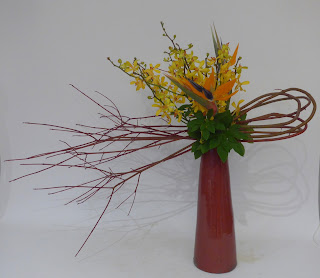Hello all,
Well, June has been a particularly busy ikebana month, even by my standards. I taught my usual classes, went to Brisbane to run two days of workshops (more about that later) and have been preparing for a workshop with the Victorian group on Saturday.
For our last
lesson I set the theme from the proposed book 5 'The 50 principles of Sogetsu'.
I asked the students to read them again, pick one that resonated with them and
interpret it in an ikebana arrangement. I explained that my role as the teacher
was to help with the arrangement itself but the concept was theirs entirely.
I made three examples, the first no. 36
- 'In addition to the colours of flowers, pay attention to containers, pedestals, walls and lights'. I placed my basket arrangement against a yellow wall and used
viburnum opulus in its Autumn colours and clivia caulescence flowers as well as
yellow berries from a tree that I have not been able to identify. I'm including
a close up of the berries branch in the hope that someone may recognize it and
let me know.
 |
| There are, usually, more berries in each stem than are shown here |
My second example no. 44 - 'Be sure to make definite points of emphasis and avoid redundancy in the arrangement'. For me, the emphasis or focal point is the meeting of the bull rushes. I deliberately avoided the use of flowers as it would have created another focal point.
And lastly, no. 29 - 'Study arrangements that
can be made without containers. Study dried and coloured materials as well'.
You may remember the arrangement I made with strelitzia nicolai in my previous
post. Well, when the flowers died, I removed them and cleaned and polished the
remainder and made this arrangement without a container. The points of this material are too soft to hold up its weight, so I inserted sticks to hold it up.
Lucy and Helen both picked no. 30 - 'Learn
the spirit of artless art. Create a work with bones, flesh and skin,
understanding the different levels of formality, Shin, Gyo and So, or formal,
informal and casual'.
Lucy made two arrangements, the first one 'formal'
and the second 'casual'.
 |
| Garirya elliptica and camelia |
 |
| Yellow gingko leaves and wisteria |
Helen's arrangement using lichen covered branches and jonquils.
Helen also picked no. 31- 'Ikebana may be comparable to painting, music or sculpture'. She used gyamea leaf and crab claw heliconia.
Robyn picked no. 49 - 'The four principles of
ikebana are a fresh approach, movement, balance and harmony; the three elements
are line, colour and mass'. Robyn was the envy of the rest of the class because
her very creative husband, Harry made this gorgeous iron container for her. In it she used coloured box thorn, wisteria vine and a stunning double banksia.
Bredenia picked no. 50 - 'Cultivate an eye
for appreciation and a hand for creation. A sense of balance is essential. This
can be achieved only through constant practice'. She used dried strelitzia nicolai leaves, red hot pokers and alstroemeria leaves.
And last but by no means least, Vicky picked no. 26 - 'When arranging, take a
view of the work from a couple of paces away'. She used agave and bull rush.
Bye for now,
Emily










































